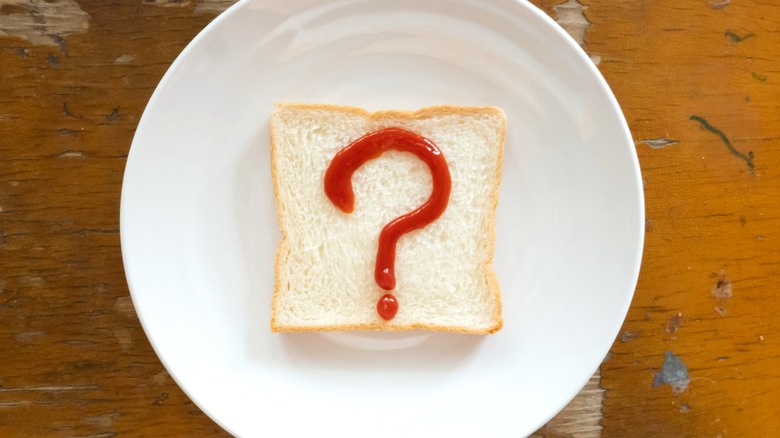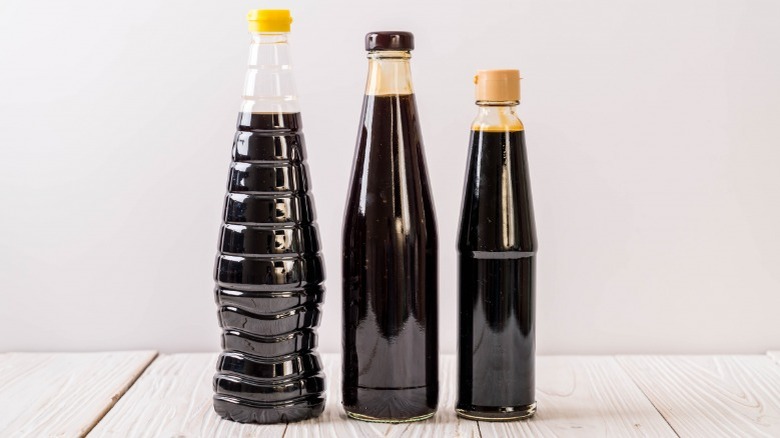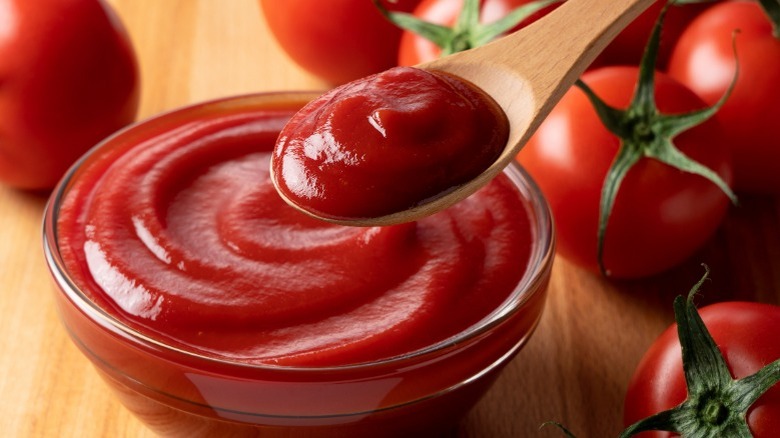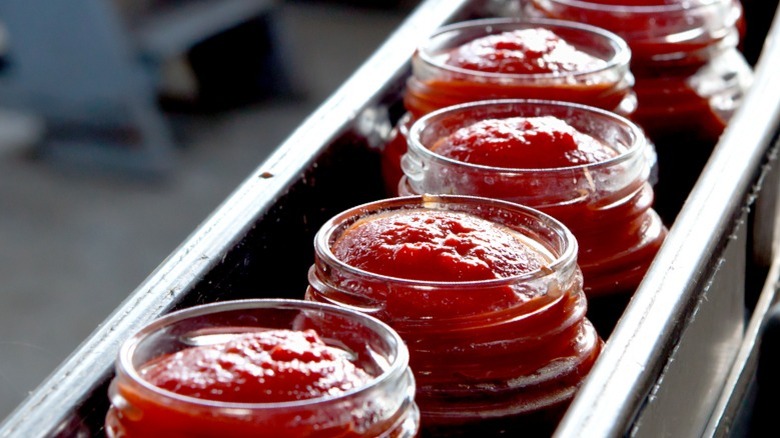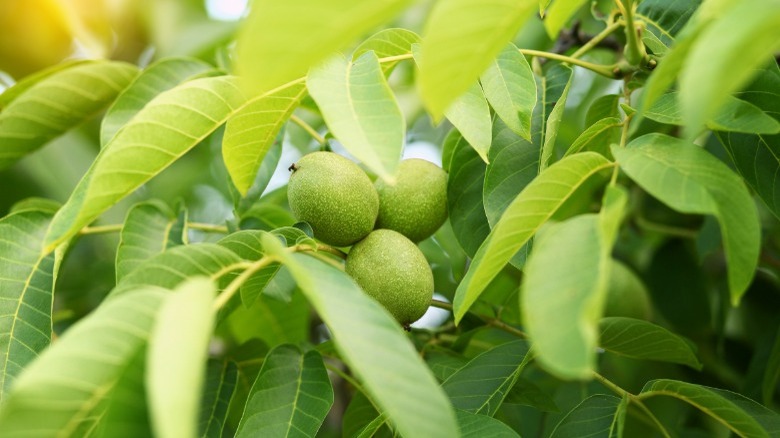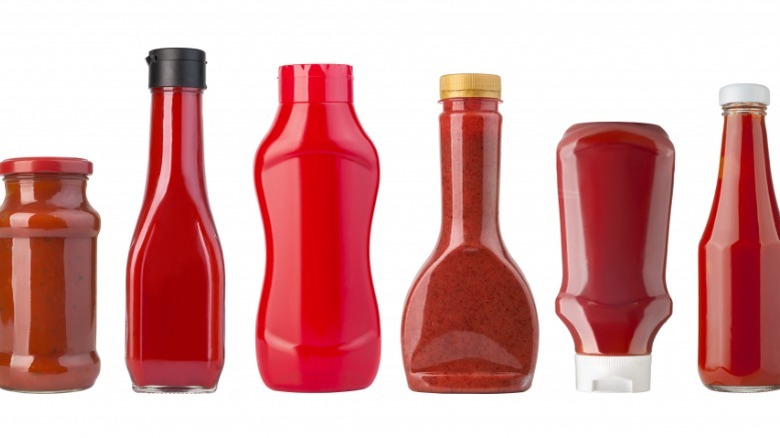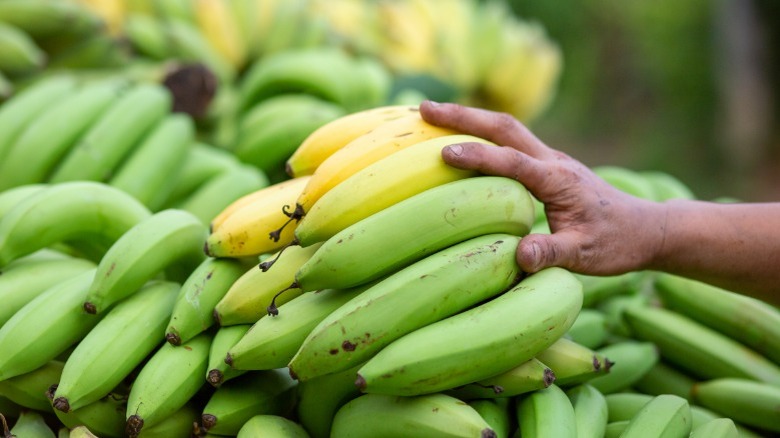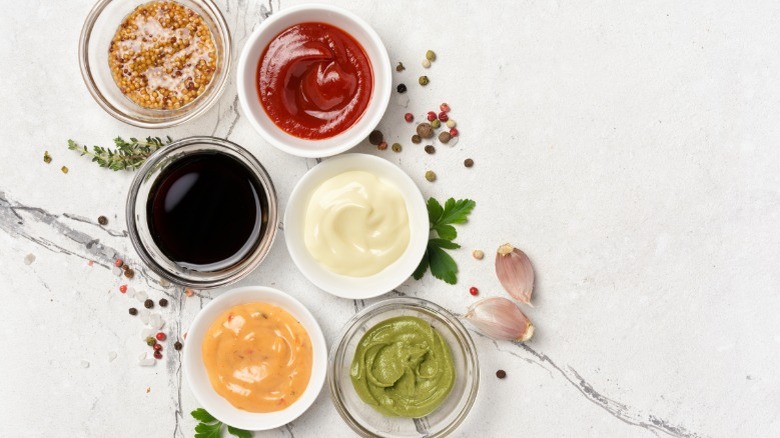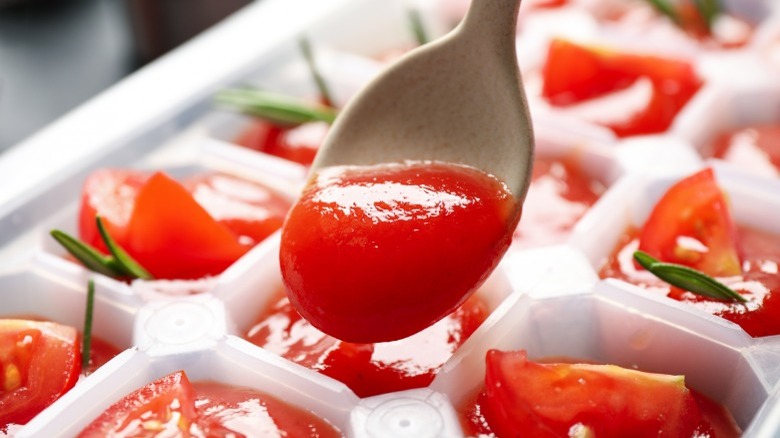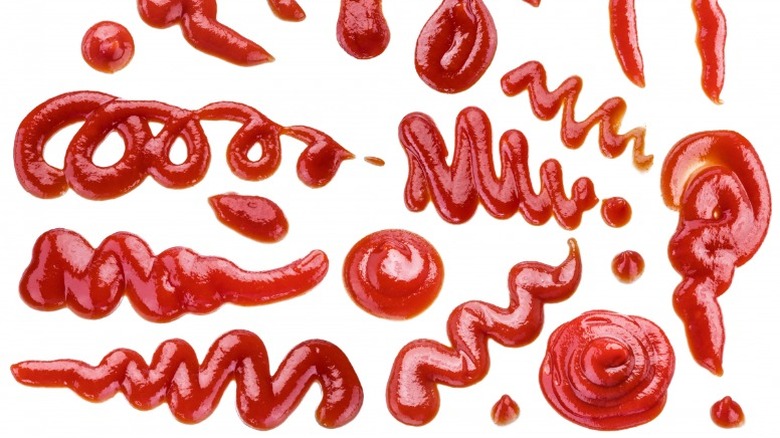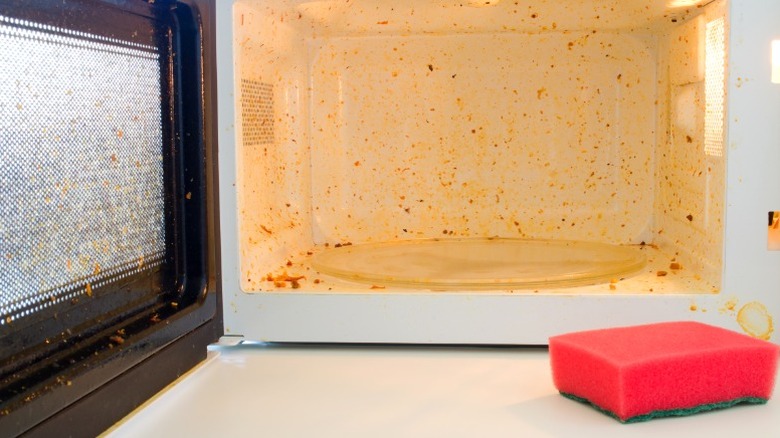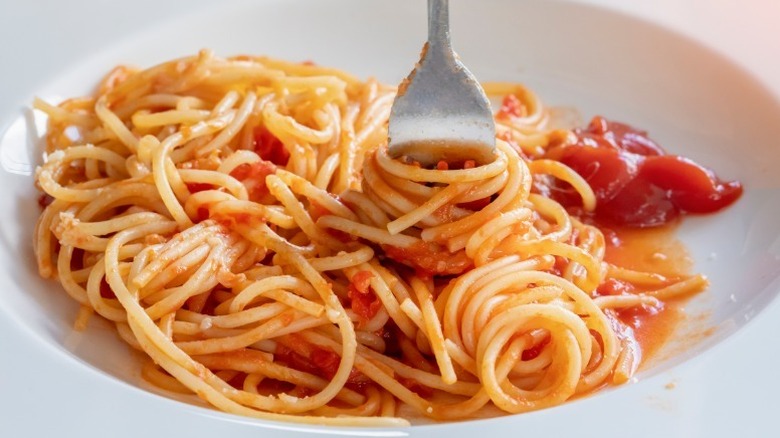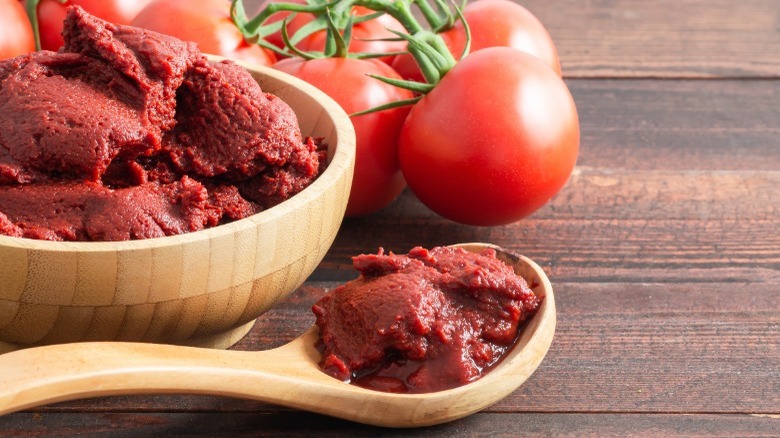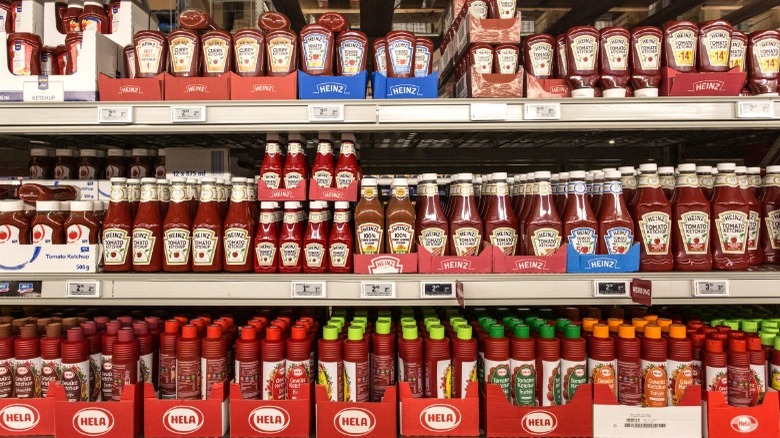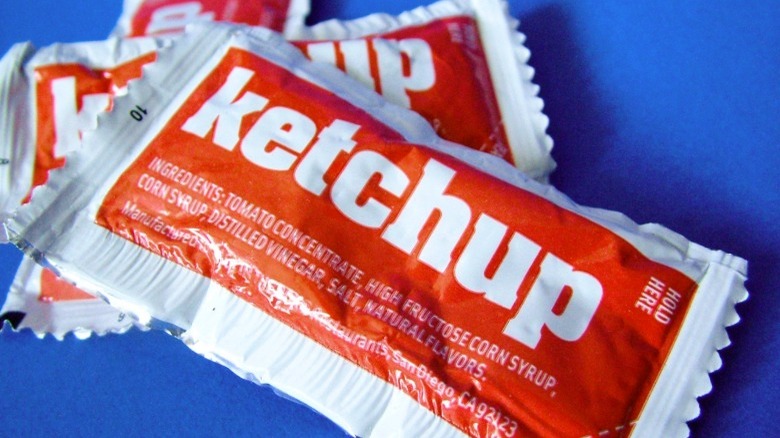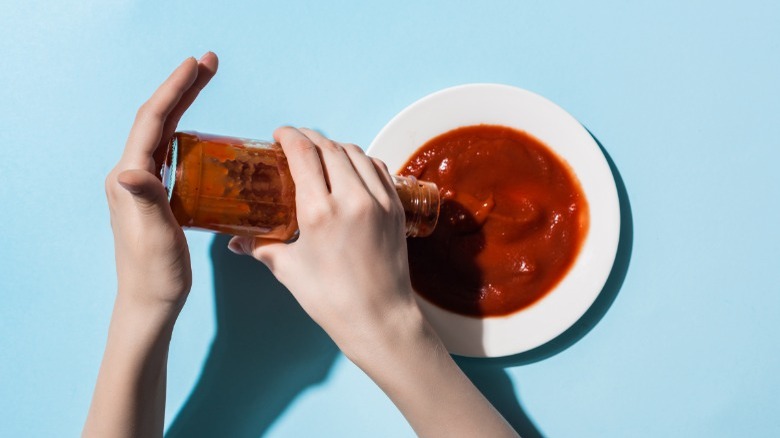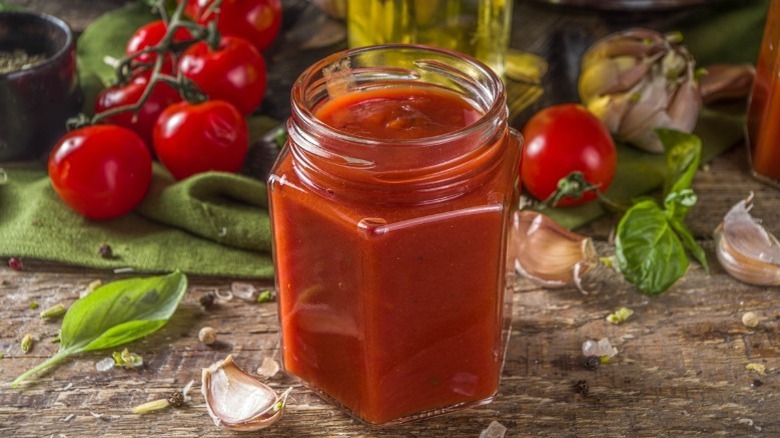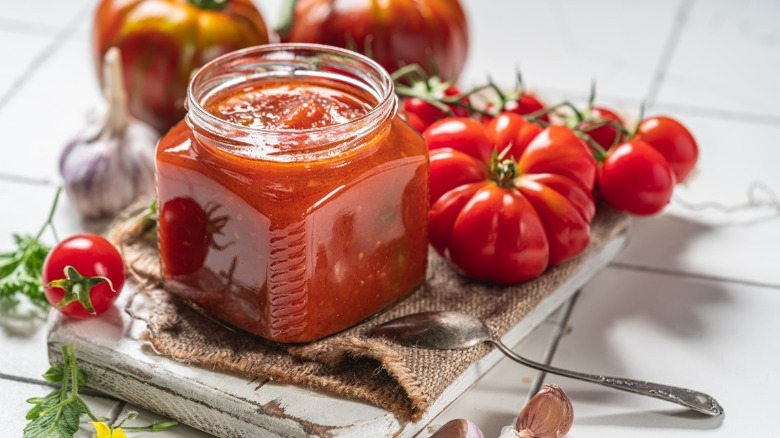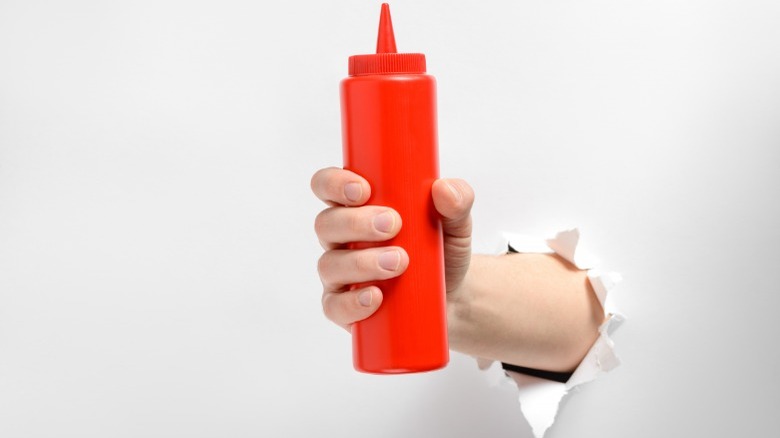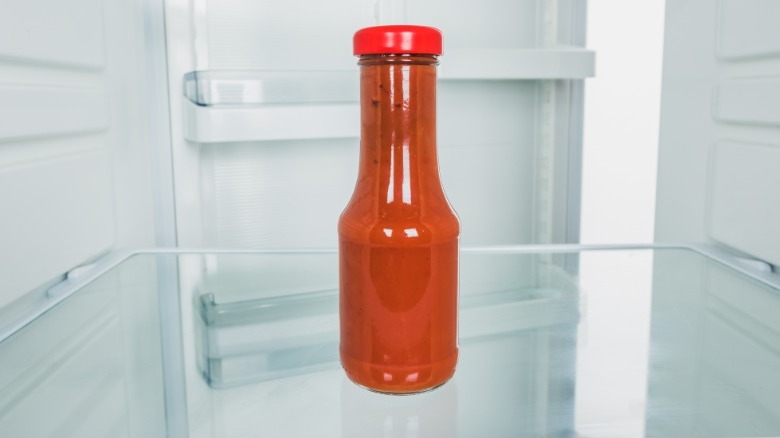Everything You Need To Know About Ketchup
From its humble beginnings in the late 18th century, ketchup has come a long way. Originally a concoction of anything but tomatoes, the recipe has evolved over time to now have dozens of flavors. Nowadays, ketchup is an essential ingredient in many dishes, from burgers and fries to sauces, stir-fries, and meatloaf. But what makes it so special?
Ketchup is a surprisingly complex condiment despite its simple ingredient list. It has a wide range of uses, from traditional to controversial. Ketchup has also been credited with changing America's food culture. Its popularity has turned it into a cultural symbol rather than simply a sauce. In fact, two record-breaking ketchup memorials can be found in one U.S. state. One of them is a ketchup bottle, which, even in its normal form, is an engineering marvel in itself. It is now an icon of food packaging and a testament to human ingenuity — and yet people still struggle to get the sauce out. With all that said, there's plenty more to learn about this iconic condiment. Read on to find out everything you ever wondered about ketchup.
The origins of ketchup lie on the other side of the world
The deceivingly all-American sauce has a long and storied history. Originating in Southeast Asia during the 17th century, ketchup was initially made with a surprising ingredient you won't see on the back of the bottle today — fermented fish. This gave the condiment a unique, salty flavor which was popular among the locals. Over time, the recipe began to change and was eventually made with tomatoes. However, despite its modern popularity, the original recipe remains unchanged, relying on the same fish and spices as it did centuries ago.
Tomatoes were a late addition to the ingredient list
As soon as the fishy proto-ketchup reached the Old World in the 18th century, it started being altered to local tastes. However, the first recipes of Western ketchup did not include tomatoes, as those were a relatively new and often feared ingredient at the time, dubbed "poison apples," according to Smithsonian Magazine. Instead, the ketchup of yore was made with pickled mushrooms, walnuts, cucumbers, and oysters. It wasn't until 1876, when Henry J. Heinz started selling his signature tomato ketchup, that the sauce we know and love today became a mainstay.
Ketchup was a 19th-century medicine
Before it became the ever-present condiment in American homes, ketchup was used in a surprising way. John Cook Bennett, a 19th-century physician, believed that ketchup was a panacea and marketed it as a health pill. The "ketchup pill" was believed to be able to cure a variety of ailments, such as indigestion, headaches, and even cholera. Made from tomato extract and spices, it was widely accepted and sought-after, as people believed it to be a cure-all, and their popularity might have contributed to the country-wide acceptance of tomatoes in the late 1800s (via Mental Floss).
Tomato ketchup changed American food forever
Since it was first introduced in the 1800s, tomato ketchup has become an integral part of many dishes and has changed American food forever. However, its influence goes beyond topping burgers, hot dogs, and fries. Its recognizable tangy and sweet flavor was born out of the industrial-age quest for shelf stability, and it was achieved through the use of vinegar, sugar, standardized packaging, and new sterilization methods introduced by Heinz. A century later, ketchup production continued influencing food technologies, including a mechanical tomato harvester and tomato breeds ideally suited for sauce making (via Smithsonian).
Jane Austen was a fan of ketchup — but not just any kind
Before industrialized ketchup took over the world, it was made at home from local ingredients. Even the 18th-century novelist Jane Austen may have enjoyed some ketchup with her favorite dishes. But it was nothing like the ketchup we know today. According to Austen's best friend Martha Lloyd's household book, the family recipe for ketchup included green walnuts, vinegar, salt, cloves, mace, ginger, nutmeg, peppercorns, horseradish, and shallots. The fermented mixture was boiled, poured into an earthen pan, and allowed to cool before bottling (via Language of Food).
The ketchup bottle evolution is a lesson in industrial design
Have you ever wondered why that ketchup bottle in your fridge looks the way it does? Its shape, size, and functionality are not random. As The Packaging Company explains, the original glass bottle reigned for almost a century until the squeeze bottle came along in 1983. But the 2001 upside-down bottle was a real breakthrough. It relied on gravity to push the sauce out, making the ketchup-pouring issues obsolete. After decades of growth and development, Heinz wants to invent a new ketchup bottle that's renewable, recyclable, and paper-based by 2025.
Banana ketchup's popularity is a product of WWII
If you're familiar with Filipino cuisine, you have likely heard of banana ketchup. But did you know it was a product of wartime ingenuity? Banana ketchup's popularity soared during WWII due to the shortages of tomatoes in the Philippines. As a result, María Orosa, a local chemist and food scientist, developed a sauce using bananas as a substitute for tomatoes. Together with sugar, vinegar, spices, and a bit of red food coloring, it turned out to be a hit. Its low price and unique flavor helped it to become a lasting favorite.
Ketchup is not America's favorite condiment
This might come as a shock, considering 97% of Americans have a bottle of it in the fridge, but ketchup is not the most popular condiment in the U.S. in terms of sales. There, mayonnaise reigns, with annual sales reaching $2 billion, compared to ketchup's modest $800 million (via People). However, in terms of sheer territory, ketchup is still number one, favored by exactly half of the states (via Zippia). Results of a 2022 Tasting Table survey also favor ketchup, with 31.63% of respondents naming it as their favorite condiment to add to food.
France has had a ketchup ban for over a decade
Believe it or not, some places have an institutionalized disdain for ketchup. For example, you won't find ketchup in French schools because France banned the condiment entirely in 2011. The government argued that ketchup wasn't in line with traditional cuisine and that its presence was watering down the heritage of French school cafeterias. Consequently, ketchup was removed from school menus, and while students may bring their own, it's not served in cafeterias. Over a decade later, the ban is still in place, and ketchup continues to be absent in schools.
You can get ketchup in liquid, frozen, and powdered forms
Ever since its invention, ketchup's physical state has continued to evolve. Regular bottled ketchup is the most common form, but it's no ordinary liquid. It's a non-Neuthonian fluid with fluctuating viscosity and flowing ability, which affects the way it pours and spreads (via Scientific American). Freezing is possible, though you might want to avoid it, as it will affect the consistency and flavor. Powdered ketchup, such as Trader Joe's new seasoning blend, is a more recent innovation that might become a lighter yet still umami-packed alternative to the traditional sauce.
There is a fanciness scale to ketchup
Store-bought ketchup might not seem like a fancy condiment, yet legally, it can be. The fanciness of ketchup is graded according to the United States Department of Agriculture's standards of color, consistency, absence of defects, and flavor. Grade A, or "fancy," ketchup contains over 33% solids by weight and scores over 85 points on the criteria review. Grades B and C, or "extra standard" and "standard," brands have a lower quantity of solids by weight and score lower on the grading test. But if you're questioning whether your ketchup is fancy, don't fret: most name-brand varieties are.
Ketchup is not microwave-friendly
Ketchup can be a messy condiment to work with. Once you get it out of the bottle, microwaving it on top of some food might seem like a good idea. However, you should never microwave ketchup because doing so ruins its flavor. Ketchup also tends to become thick and gummy, making it difficult to spread. What's worse, if you try to microwave ketchup in its original plastic or metallic container, it might explode or catch on fire. Instead, it's best to let ketchup warm up naturally or to heat it in a pot on the stove.
Italians have strong feelings about ketchup
While it may seem omnipresent, versatile, and universally loved across the world, ketchup is often involved in what some consider to be a culinary crime. According to a YouGov survey, Italians find pairing it with spaghetti the most unacceptable "abuse" of Italian food. Alongside having pineapple on pizza, ketchup on pasta is seen as a gross misappropriation of a national dish. Interestingly enough, surveyed Americans agree it's wrong, yet out of the 17 nations and territories studied, 11 didn't mind the pairing, with internet users in Indonesia and Hong Kong showing particularly strong approval.
There are easy ways to substitute ketchup
When you're in a pinch, there are a number of delicious ketchup alternatives to choose from. Some of the best substitutes for ketchup include salsa, which is almost always tomato-based and works wonders on savory foods, and tomato paste, which is a great substitute when making sauces and marinades. Sriracha mayo adds a moderately spicy kick that pairs well with burgers and fries, and sambal oelek adds a unique chili flavor perfect for Asian dishes. Similarly to ketchup, barbeque sauce contains tomatoes, sugar, and vinegar and is great for adding a smoky flavor.
Ketchup should be stored in the refrigerator
If you have ever wondered whether ketchup should be stored in the refrigerator, the short answer is yes. Considering it's made with vinegar and is naturally acidic, it's rather shelf-stable when unopened. But keeping a used bottle at room temperature can cause rapid bacteria development. Storing it in the fridge will keep it safe for consumption. The best place to store ketchup and other condiments is the refrigerator door since they aren't too temperature-sensitive and fit there neatly. Keeping ketchup in the fridge is key to preserving its flavor and preventing bacterial growth.
Over a dozen of ketchup flavors exist
If you ever get tired of plain tomato ketchup, there are plenty of flavors to choose from, whether you buy it or make it yourself. Habanero, jalapeño, Thai chili, sriracha, chipotle, and curry are some of the best ketchup flavors you can find at the store. If you're looking for something milder, try vegetable ketchup or a black pepper variety. Making your own ketchup is a great way to customize the flavor and precisely tailor it to your liking. You can use mushrooms, other fruits and berries, or even beer as a base!
There's a practical reason behind freezing ketchup packets
It's likely that you consume leftover ketchup packets as usual, keep them in a drawer forever, or toss them. But what if you froze them? Surprisingly, it would make a perfect solution for a variety of situations. They can be used to soothe small bruises in children, reduce puffiness in adults' eyes, or even be placed in lunchboxes as mini ice packs. Freezing them doesn't take up much space and keeps them ready to use whenever needed. So freeze those extra packets for your next emergency — you'll be glad you did!
You can get it out of the bottle using science
Who hasn't struggled with this stubborn sauce at least once in their lifetime? A simple understanding of its science can help: as a non-Neuthonian fluid, ketchup requires force to change its viscosity and get it moving. Say goodbye to palm-bruising days forever because you're about to learn the best way to get ketchup out of the bottle operating on this principle. First, shake the bottle. Then, flip it upside down and give it one last good shake. Finally, pop off the lid and tip it down at a 45-degree angle.
There is a difference between tomato ketchup, paste, sauce, and jam
While all four are made from tomatoes, each is distinct in its own way. The difference between tomato sauce and tomato paste lies in density. The sauce made with herbs and spices is thick, but the paste is thicker. It's made from cooked, strained tomatoes or reduced tomato sauce and is often used as a flavoring in soups and condiments. Tomato jam is different from ketchup due to its thicker, spreadable consistency and spicier flavor, while ketchup is typically sweet, tangy, and runny in comparison to the other three.
Ketchup can be used outside your plate
You wouldn't know it if you hadn't tried it, but ketchup has earned an online reputation as an effective cleaning solution. According to The Cleaning Mommy, you can use it to clean toilets, shine keys, clean silver jewelry, and more. Ketchup can even fix your copper pans, should they ever need a polish. The reason these hacks work is the natural acidity of ketchup, which can be effective when cleaning metals or breaking down tough things like burnt food. If you've never tried cleaning with ketchup, start small and see how it goes.
There's a scientific reason kids love ketchup
For most children, ketchup is the beloved go-to condiment. Why do they love it so much? For starters, it's sweet and packed with umami, both of which make other flavors more bright. Additionally, its bright red color is a visual cue that activates the brain's reward system, making it even more appealing. Another reason is a genetically predisposed sensitivity to bitter flavors, which are often found in vegetables, and which ketchup helps mask. Finally, ketchup is a reliable gastronomic companion in the universe of unknown foods children constantly get exposed to (via HowStuffWorks).
It's legally allowed to have unsavory ingredients
Grab a bottle of ketchup from your refrigerator. What does the ingredient list say? Some form of tomatoes, some form of sugar, vinegar, salt, spices, and ... insect eggs. That's right, ketchup is one of the foods that may contain them. When tomato plants are cultivated, they are susceptible to insects, which can leave traces. Therefore, the USDA tolerates a small amount of insect parts that may be present in ketchup or in the ingredients used. For ketchup, the legal limit is up to 30 eggs and one or more parts per 100 grams.
Making your own ketchup couldn't be easier
Want to ensure you are eating ketchup that is fresh and perfectly tailored to your own tastes? Make your own! When tomatoes are in season, homemade ketchup can also be significantly cheaper than fancy store-bought varieties, making it an economical choice. Finally, making your own ketchup is an enjoyable and creative experience, allowing you to experiment with different ingredients and flavors. If you need a place to start, look no further than this simple homemade ketchup recipe. It's made by mixing tomato paste with sugar, vinegar, and spices — simple and affordable any time of year.
Illinois has a record-breaking love of ketchup — but not on a hotdog
Standing at an impressive 170 feet tall, the World's Largest Catsup Bottle is located in Collinsville, Illinois. This Guinness World Record holder is a replica of the old Brooks catsup bottle and is a popular tourist attraction. The same town gave birth to the world's largest ketchup packet, which was filled with approximately 127 gallons of sauce (via Guinness World Records). Both the bottle and packet are a testament to the state's strong love of ketchup, yet authentic Chicago-style hot dogs are unapologetically and rigidly served without it.
It can take certain dishes to the next level
Ketchup's bright yet versatile flavor allows it to go beyond being a dipping sauce for french fries. In fact, it can be used to elevate any dish by adding an extra depth of flavor. For one, it will take your stir-fry up a level by adding a touch of acidity and sweetness. It's also a non-negotiable secret ingredient in meatloaf recipes — even the vegetarian ones — where it's used both in the mix and as a glaze. Finally, ketchup can also be used as a sauce base or a marinade.
You can use it as a base for other sauces
Tomato ketchup has an agreeable, balanced flavor that can make an ideal base for more complicated sauces. A sweet and tangy BBQ sauce is basically a glorified version of ketchup, with more sugar and vinegar, as well as oil and spices. A creamy remoulade sauce is made by mixing half a dozen different condiments, including ketchup, mayo, horseradish, mustard, and more, with lemon, garlic, onions, and herbs. Fancy a homemade Thousand Island dressing? Simply mix your ketchup with mayo, sweet relish, vinegar, and alliums. With ketchup, the possibilities are endless.
Some U.S. presidents share a curious connection with ketchup
You wouldn't know it from looking at it, but ketchup can get political. Ronald Reagan's administration caused the "ketchup as a vegetable" controversy in an attempt to cut school lunch costs and replace expensive vegetables with cheaper processed foods (though ketchup was never mentioned in the regulations). During Barack Obama's presidency, in an attempt to make school lunches healthier, the USDA offered to count a half-cup of tomato paste as a single serving of veggies (as opposed to the then-standard two tablespoons). Needless to say, both failed, and the presidents were subject to backlash.
Putting ketchup on certain foods sparks controversy
Ketchup has become a controversial condiment in recent years, as its use on certain foods can spark heated debates online. While some people swear by the sweet and savory taste of ketchup on staples such as hot dogs, pizza, macaroni and cheese, eggs, rice, and pasta, others argue that it is an unwelcome addition to these dishes. Additionally, ketchup on ice cream has been met with vocal opposition, while pairing it with cottage cheese has been deemed sacrilegious. Whatever your opinion may be, it's clear that ketchup continues to be a divisive topic.
Store-bought ketchup lasts long — but not forever
Ketchup is a pantry staple, but it doesn't last forever. Unopened ketchup typically lasts up to two years if stored in a cool, dry place. Once opened, it should be refrigerated and used within six months. Here's how to know if your ketchup has gone bad: if it's thicker and darker than usual and has an off-smell, it's best to discard it. If you accidentally eat expired ketchup, you may experience an upset stomach. To avoid this, regularly check and replace your ketchup so you always have a fresh bottle on hand.
